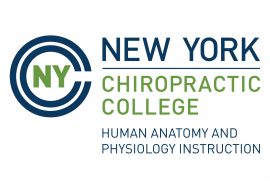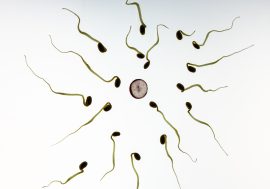00:45 | Sperm Speed
02:48 | Sponsored by HAPS
03:32 | Hematopoiesis in the Gut
07:04 | Sponsored by AAA
07:22 | Swallow Legos Much?
10:41 | New Sponsor: MS-HAPI Program
15:23 | Featured: Mid-Semester Check-Ins Keep Your A&P Course on Track
If you cannot see or activate the audio player click here.
Questions & Feedback: 1-833-LION-DEN (1-833-546-6336)
Follow The A&P Professor on Twitter, Facebook, Blogger, Nuzzel, Tumblr, or Instagram!
Vulnerability sounds like truth and feels like courage. Truth and courage aren't always comfortable, but they're never weakness. (Brené Brown)
1 | Sperm Speed
2 minutes
We know that some sperm are fast and some are slow. And it seems that if the sperm are generally pretty slow, that may reduce fertility. Now we have a clue why that may be so.
- Slow sperm may fail at crashing ‘gates’ on their way to an egg (brief summary; includes video) my-ap.us/2BP9yb0
- Strictures of a microchannel impose fierce competition to select for highly motile sperm (research article) my-ap.us/2BLNi1J
2 | Sponsored by HAPS
0.5 minute
The Human Anatomy & Physiology Society (HAPS) is a sponsor of this podcast. Did you know there's a one-day regional HAPS conference in March? Check it out. You can help appreciate their support by clicking the link below and checking out the many resources and benefits found there.

3 | Hematopoiesis in the Gut
3.5 minutes
In Episode 37, I mentioned the "reserve hematopoiesis" in bone marrow. New information shows that significant hematopoiesis occurs in the adult intestine. In an allograft of intestinal tissue, as may occur in patients with a GI disorder, donor stem cells and progenitor cells produce white blood cells that circulate in the recipient's blood stream.
- Some blood cells have a surprising source—your gut (brief summary) my-ap.us/2BMjEsZ
- Human Intestinal Allografts Contain Functional Hematopoietic Stem and Progenitor Cells that Are Maintained by a Circulating Pool (research article) my-ap.us/2BMr8vY
4 | Sponsored by AAA
0.5 minutes
The searchable transcript for this episode, as well as the captioned audiogram of this episode, are sponsored by The American Association of Anatomists (AAA) at anatomy.org. Their big meeting is in April at the Experimental Biology (EB) meeting in Orlando FL. Check it out!
5 | What Happens When You Swallow a Lego?
3.5 minutes
How long does it take for a Lego piece to travel through the alimentary canal? The answer is in—er, I mean out.
And learn about the Stool Hardness and Transit (SHAT) score and the all-important Found-and-Retrieved Time (FART) score. That alone is worth the price you paid to listen to this episode.
- Study reveals how long it takes for LEGO head to pass through adult human digestive tract (brief summary) my-ap.us/2BGZ4dF
- Everything is awesome: Don't forget the Lego (research article) my-ap.us/2BMjGB7

6 | New Sponsor! MS-HAPI Graduate Program in A&P
4.5 minutes
The Master of Science in Human Anatomy & Physiology Instruction—the MS-HAPI—is graduate program for A&P teachers. A combination of science courses (enough to qualify you to teach at the college level) and courses in instructional practice, this program helps you power up your teaching. Kevin Patton is a faculty member in this program. Check it out!

7 | Featured: Mid-Semester Check-Ins Keep Your A&P Course on Track
25.5 minutes
A recent conversation with Krista Rompolski brought up her practice of a mid-semester student survey. Why does she do that? Find out in this episode that focuses on ways to "take the temperature" of your course while there's still time to fix anything that needs fixing.
- End-of-Term Reviews Help Keep Your Course on Track | Episode 17 (where I first bring up deconstructing your A&P course)
- Lion Tamers Guide to Teaching (Kevin's blog)
- Lion tamers are very vulnerable, because nobody is stronger than a lion (which can eat you). But it works if you listen to the lions and find ways to get them to want to do what you want them to do. That can work with human students, too, even if they seem ready to eat you alive.
- Spaced Retrieval Practice | Episode 1
- Advice for faculty members on how to teach students how to learn (opinion piece from Inside Higher Ed) my-ap.us/2BPMIQj
- Clickers (Kevin's online seminar on using student response systems)

If the hyperlinks here are not active, go to TAPPradio.org to find the episode page.
- More details at the episode page.
- Transcript available at the script page.
- Listen to any episode on your Alexa device.
- Join The A&P Professor social network:
- Blog
- Twitter @theAPprofessor
- Facebook theAPprofessor
- Instagram theAPprofessor
- YouTube
Transcript and captions for this episode are supported by the
American Association of Anatomists.
anatomy.org
The Human Anatomy & Physiology Society
provides marketing support for this podcast.
theAPprofessor.org/haps
NYCC's online graduate program in
Human Anatomy & Physiology Instruction (HAPI)
supports distribution of this podcast free to all users.
nycc.ed/hapi
Amazon and TextExpander referrals also help defray podcasting expenses.
(Clicking on sponsor links helps let them know you appreciate
their support of this podcast!)
Click here to listen to this episode—or access the detailed notes and transcript.




No comments:
Post a Comment